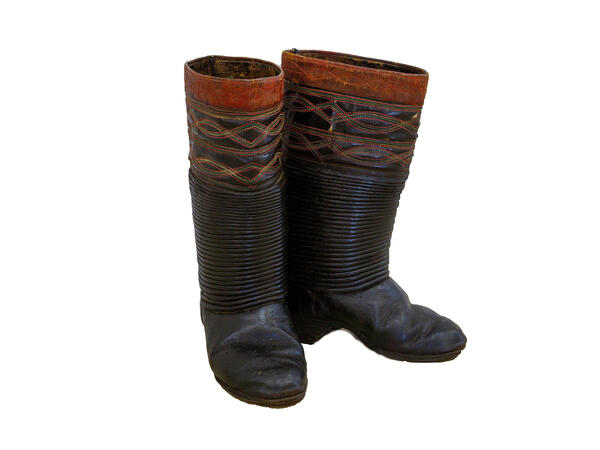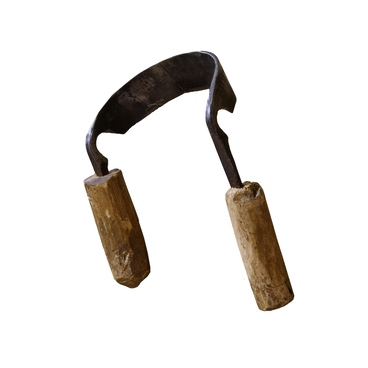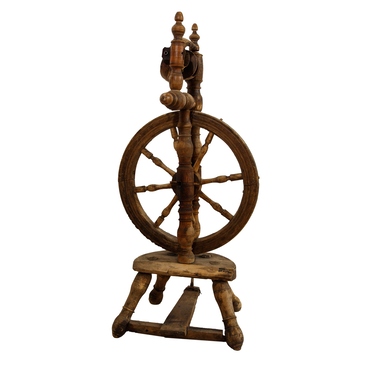As a rule, the Mordvins did not wear leather shoes. The exception is women’s knee-high boots “sermof markhta kyamot”, displayed in the exhibition. At the end of the 19th century, theн were worn on holidays and were very popular among Moksha women.
These black rawhide boots belonged to Anastasia Shchukina, a resident of the Vadovskie Selischi village, Zubovo-Polyansky District, MASSR.
The lower part of the straight bootlegs is shirred: 27 shirrs on the left boot and 29 shirrs on the right boot. is trimmed with black leather substitute, red, green, and yellow threads stitching, and the edges were painted red.
The boot’s toe was narrowed. It has a full double sole and a built-up heel with metal heel plates. The shirred boots were made of cow or calf rawhide. The upper part of the boot leg was often lined with red morocco leather, with patterned stitches and copper plaques beneath it. Such shoes had a heavy heel counter, which was called “siren kochkyargat”, which is translated as “copper heel”. It was called as such because of drove-in nails with big copper heads.
The copper heel plates were nailed to the boot-wide heel base. Many Mordovian songs mention girls dancing in their knee-high boots and tapping their heel plates.
The bootleg shirrs were made as follows: the bootleg reverse side was glued with burlap and “harmonica (slouchy)” was made on it using pliers. Then shirrs were joined with the boot’s toe.
As the fashion for “squeaky boots” emerged, craftsmen began to insert birch bark in-between the insole and the sole. Later, it was changed for a piece of cloth inserted in the same place of the boot. In different areas, the shoes were decorated following different patterns. Some boots were shirred just above the ankle, while others — up to the top of the bootleg.
For example, in the Staroshaygovsky district, the upper part of the bootleg was covered with fabric ornament-braid “kyame petks” trimmed with tape, buttons, and sequins.
By comparison, the Tengushevsky Erzya people wrapped the bootleg top with a lacquered leather overlay with multicolored threads’ patterned stitch. The shoemaking craft with shirrs propagated from father to son. Craftsmen bought tanned leather or tanned it themselves.
Each part of the boot was cut out of a certain part of the cowhide: the sole — from the spine, the inner insole — from the underbelly, and scrap leather was used for the heel. Some craftsmen were adept at “pulling out” a boot out of a single piece of leather. Those who had this skill were called “vytyagala (puller)”.
In the 1920s and 1930s, the shoemakers worked nearly in every district of Mordovia. Some craftsmen took orders to make traditional “Mordovian boots” until the 1960s. In the villages of Staroye Drakino, Zhuravkino, Staraya Terizmorga, and many others, the girls wore knee-high boots with the traditional costume during the holidays. The knee-high boots were an obligatory element of the Mordovian stage costume of Moksha folklore ensembles.
These black rawhide boots belonged to Anastasia Shchukina, a resident of the Vadovskie Selischi village, Zubovo-Polyansky District, MASSR.
The lower part of the straight bootlegs is shirred: 27 shirrs on the left boot and 29 shirrs on the right boot. is trimmed with black leather substitute, red, green, and yellow threads stitching, and the edges were painted red.
The boot’s toe was narrowed. It has a full double sole and a built-up heel with metal heel plates. The shirred boots were made of cow or calf rawhide. The upper part of the boot leg was often lined with red morocco leather, with patterned stitches and copper plaques beneath it. Such shoes had a heavy heel counter, which was called “siren kochkyargat”, which is translated as “copper heel”. It was called as such because of drove-in nails with big copper heads.
The copper heel plates were nailed to the boot-wide heel base. Many Mordovian songs mention girls dancing in their knee-high boots and tapping their heel plates.
The bootleg shirrs were made as follows: the bootleg reverse side was glued with burlap and “harmonica (slouchy)” was made on it using pliers. Then shirrs were joined with the boot’s toe.
As the fashion for “squeaky boots” emerged, craftsmen began to insert birch bark in-between the insole and the sole. Later, it was changed for a piece of cloth inserted in the same place of the boot. In different areas, the shoes were decorated following different patterns. Some boots were shirred just above the ankle, while others — up to the top of the bootleg.
For example, in the Staroshaygovsky district, the upper part of the bootleg was covered with fabric ornament-braid “kyame petks” trimmed with tape, buttons, and sequins.
By comparison, the Tengushevsky Erzya people wrapped the bootleg top with a lacquered leather overlay with multicolored threads’ patterned stitch. The shoemaking craft with shirrs propagated from father to son. Craftsmen bought tanned leather or tanned it themselves.
Each part of the boot was cut out of a certain part of the cowhide: the sole — from the spine, the inner insole — from the underbelly, and scrap leather was used for the heel. Some craftsmen were adept at “pulling out” a boot out of a single piece of leather. Those who had this skill were called “vytyagala (puller)”.
In the 1920s and 1930s, the shoemakers worked nearly in every district of Mordovia. Some craftsmen took orders to make traditional “Mordovian boots” until the 1960s. In the villages of Staroye Drakino, Zhuravkino, Staraya Terizmorga, and many others, the girls wore knee-high boots with the traditional costume during the holidays. The knee-high boots were an obligatory element of the Mordovian stage costume of Moksha folklore ensembles.



